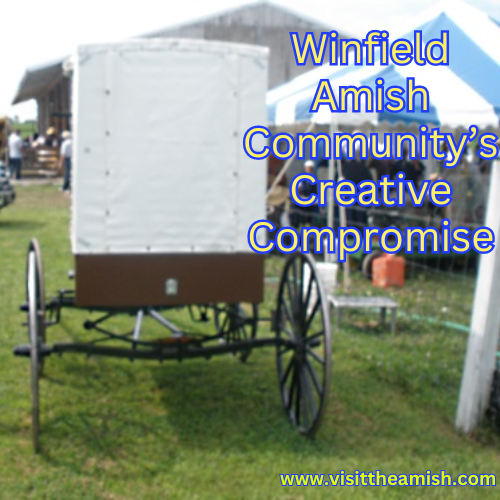The Amish and the Slow Moving Vehicle Triangle: Tradition Meets Safety
In most Amish communities across America, the bright orange Slow Moving Vehicle (SMV) triangle has become an integral part of the iconic horse-drawn buggy. For the majority of Amish, this safety feature is accepted without much thought, seamlessly blending into their traditional way of life while serving a crucial modern purpose.
However, the relationship between the Amish and the SMV triangle is not without its complexities. Some Amish groups, particularly the more conservative sects, have raised objections to its use. Their concerns stem from deeply held religious beliefs and a desire to maintain separation from the modern world.
The Swartzentruber Amish, known for their strict adherence to traditional ways, have been at the forefront of resistance to the SMV triangle. They argue that its bright colors are too “worldly” and that relying on a man-made safety device demonstrates a lack of faith in God’s protection. This stance has led to legal conflicts in some areas, though many jurisdictions have come to accept their position.
Interestingly, not all conservative Amish groups share this view. The Nebraska Amish of Winfield, Pennsylvania, have devised a unique compromise. They use the SMV triangle while their buggies are in motion on public roads, but remove it immediately upon parking. This practice allows them to comply with safety regulations while on the road, yet symbolically distance themselves from the modern device when not in use.
The Winfield community’s approach is distinctive. Observers have noted that the SMV triangle is consistently removed as soon as the horse is tied up, even before it’s unhooked from the buggy. Special brackets on the buggy allow for easy attachment and removal of the sign. This practice appears to be unique to the Winfield settlement, as Nebraska Amish in other areas don’t follow the same custom.
This creative solution exemplifies the diverse ways in which different Amish communities navigate the challenges of living in accordance with their beliefs while coexisting with the modern world. It’s a testament to the Amish ability to find innovative compromises that respect both their traditions and the safety concerns of their non-Amish neighbors.
The varying approaches to the SMV triangle across Amish society highlight the diversity within this often misunderstood religious group. From full acceptance to outright rejection, and creative compromises in between, the SMV triangle serves as a small but significant example of how the Amish continually negotiate their place in contemporary society while striving to maintain their traditional values and way of life.



Just another small example of the different worldly accommodations found across Amish society.
Different Amish affiliations have varying views on the use of the Slow Moving Vehicle (SMV) triangle:
1. Mainstream Amish: The majority of Amish communities willingly use the SMV triangle on their buggies. They see it as a necessary safety measure and have little objection to its use[1].
2. Progressive Amish: More liberal Amish groups not only use the SMV triangle but may also incorporate additional safety features like LED lights, flashing amber lights, and even solar panels to charge batteries for lighting[1].
3. Conservative Amish: Some conservative groups have reservations about the SMV triangle but still use it. For example, the Nebraska Amish in Winfield, Pennsylvania use the triangle while on the road but remove it when parked as a symbolic gesture of their reluctance to fully embrace it[1].
4. Swartzentruber Amish: This highly conservative affiliation generally refuses to use the SMV triangle. Their objections include its bright colors being too “worldly” and the belief that relying on a man-made safety device demonstrates a lack of faith in God’s protection[1][2].
5. Compromise solutions: Some Amish groups have found middle-ground solutions. For instance, the Amish in Ashland, Ohio use a less conspicuous grey triangle outlining a smaller orange triangle[2].
The varying approaches to the SMV triangle reflect the diversity within Amish society and how different groups balance their traditional beliefs with modern safety concerns. While most Amish recognize the importance of road safety, the more conservative groups tend to prioritize their religious convictions and separation from the modern world[1][2][4].
Citations:
[1] https://amishamerica.com/do-all-amish-use-the-slow-moving-vehicle-triangle/
[2] https://amishamerica.com/one-amish-communitys-creative-smv-compromise/
[3] https://ideaexchange.uakron.edu/cgi/viewcontent.cgi?article=1023&context=amishstudies
[4] https://www.northcountrypublicradio.org/news/story/28239/20150504/should-the-amish-have-to-put-reflective-triangles-on-their-buggies
[5] https://www.seattlepi.com/national/article/Amish-reject-orange-triangles-for-slow-buggies-1051545.php

